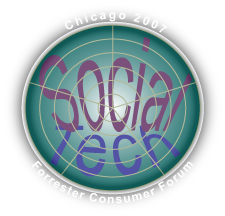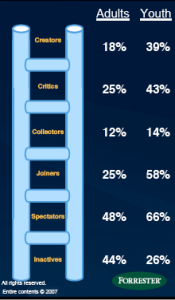… Risky, Loaded and Ready to Help You Improve Your Business
 The Global Human Capital Journal’s coverage of the Forrester Consumer Forum 2007 continues with this session on the disruptive power of customers’ Web 2.0 activity. Charlene Li, Vice President and Principal Analyst, Forrester Research, briefed the conference on the disruptive character of consumer empowerment, which she and Josh Bernoff call “groundswell.” She explained why customers were revolting, a “ladder of participation” to describe who is driving the change and some suggestions for turning revolt into reform.
The Global Human Capital Journal’s coverage of the Forrester Consumer Forum 2007 continues with this session on the disruptive power of customers’ Web 2.0 activity. Charlene Li, Vice President and Principal Analyst, Forrester Research, briefed the conference on the disruptive character of consumer empowerment, which she and Josh Bernoff call “groundswell.” She explained why customers were revolting, a “ladder of participation” to describe who is driving the change and some suggestions for turning revolt into reform.
The Global Human Capital Journal published the overall conference wrap as well as in-depth coverage of several sessions. Access all through the link to the conference logo (right). Other articles will be published in the days ahead, and we invite you to subscribe to the forum’s RSS feed to be notified as they are published.
I assume that the title’s double entendre was intentional, but in any case, it captures many marketers’ attitudes toward the so-called Web 2.0 revolution. “We don’t want our customers to change. We want to maintain our marketing models” (and control).
Charlene explained how people were coming together, who the early adopters were and how they were affecting global brands:
- Digital social technologies enable people to find each other online and collaborate. Social networks like Facebook, MySpace, LinkedIn, Orkut and intermediaries like Technorati, Google and Yahoo enable people to find each other based on common interests; moreover, they offer many defined ways for people to connect on their sites while providing privacy controls. the big change is, customers are reaching out to each other for advice on everything, including what products and services to buy. As shown in the earlier session, customers believe other customers more than experts or company employees.
- Prior to social technologies, companies controlled the means of mass communication. Today, they come across as shouting; they don’t listen to customers in ways that customers recognize.
- Charlene shared the case study of CBS and Jericho, a show that had shown some success but was subsequently cancelled when CBS put it against American Idol, and it failed to compete. The revolutionary was Shaun Daily, who asked loyal fans to let CBS know their feeling about the show by sending bags of peanuts to the president, who was buried under 20 tons! CBS put the show back on the air, but they asked loyalists to recruit new viewers, they launched a wiki to enable viewers to collaborate with staff, widgets that enabled people to invoke show content from their MySpace pages and a production blog. In short, they embraced the community and helped create vibrant collaboration with viewers.
 Then she laid out Forrester’s Framework for early adopters of social technologies, the “Ladder of Participation”: Creators are most involved because they create original content, followed by Critics (reviews, playlists), Collectors (taggers), Joiners (social networks, to be with friends), Spectators (read consumer content, blogs, videos) and Inactives (are aware but are not yet involved). See graphic right. Note the high Creator portion of Youth. Youth is currently almost double the Adult rate in every category.
Then she laid out Forrester’s Framework for early adopters of social technologies, the “Ladder of Participation”: Creators are most involved because they create original content, followed by Critics (reviews, playlists), Collectors (taggers), Joiners (social networks, to be with friends), Spectators (read consumer content, blogs, videos) and Inactives (are aware but are not yet involved). See graphic right. Note the high Creator portion of Youth. Youth is currently almost double the Adult rate in every category.- She succinctly explained how to turn “revolt” into “reformation”:
- Instead of being unhappy with customers’ negative comments, enable advocates to answer them on your behalf.
- Don’t complain when customers magnify your shortcomings with product, service or other. Ask them how they would improve what they’re unhappy about, and act on it.
- Perhaps the hardest for marketers: accept that they will take your ads and messages and twist them in video, pictures, audio and text. Allow them to create relevant messages for each other. Remember, their messages refer back to yours.
- B2C-B2B connection: these trends are mirrored within the enterprise, and you can apply many of them to the company’s relationship with employees.
- Facebook penetration is skyrocketing. Charlene mentioned that 50% of all adults online are on Facebook.
- She reminded the audience that people like to hear relevant messages. She was incredulous that Ernst and Young was one of few with effective presences on Facebook and MySpace.
Analysis and Conclusions
- Consumer empowerment is a new market force. It digitizes word of mouth, arguably the most powerful and invisible determinant of customer relationships.
- Social technologies enable P2P (peer to peer, or one to one) communication observed by millions of others. Also, conversations often scale to many to many. The point is that people are more comfortable being talked with as individuals. Companies have forgotten how to do this: they communicate through corned beef hash marketing research in which customers do not recognize themselves. They provide little mirroring. Customers mirror other customers.
- Don’t solicit customer suggestions unless you are prepared to act. They already know all of your excuses.
- Charlene’s remark about people liking to hear relevant messages reflected a possible reversal between Web 1.0 (1995-2002) and Web 2.0: Web 1.0 really resisted commercial messages and mass advertising, and senior marketing executives approach it gingerly. However, Web 2.0 provides the ability to increase appropriateness and relevance. If you think about communicating with individuals rather than demographics, you can deliver messages they value. What people hate is mass advertising, the majority of which is irrelevant and interruptive.
 Keep in mind that the Boomer generation didn’t expect to be listened to because there were few opportunities to contact companies except at the retail counter, and customers had long ago traded considerate service for low prices.
Keep in mind that the Boomer generation didn’t expect to be listened to because there were few opportunities to contact companies except at the retail counter, and customers had long ago traded considerate service for low prices.- Customers are revolting because marketers are “shouting at them” and not listening. Most important, however, they can talk with each other now. They can have “conversations,” and these make company-driven communication, which addresses masses and demographics, insensitive and irrelevant by comparison. By having P2P conversations with each other, customers are raising the bar for companies’ communications.
- In many cases, customers are better qualified to help other customers to have better experiences than company employees are. Employees by definition have a company perspective on the offering, not a customer perspective. Customer advice seamlessly integrated with company expertise is paramount.
- By helping customers to advise and service each other, the enterprise can amplify the value of its expertise and provide superior experience at a lower cost. By recognizing customers’ core competency at communicating with other customers, enterprises can think about “sourcing” appropriate “services” from other customers. However, they must make it gratifying; customers do this in their spare time.
- Enterprises that develop the competency to facilitate customer-focused collaboration will dominate the economy. Their innovation will be peerless and completely sustainable.
- For more on this, see: Market Advisory: Consumer Empowerment.

[…] More detailed treatment of the Forrester’s “Ladder of Participation,” see Your Customers Are Revolting… […]